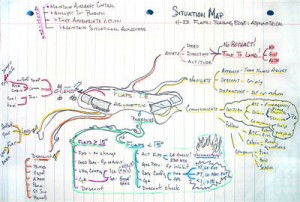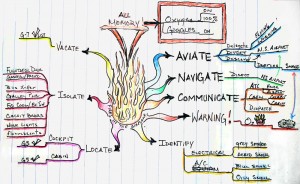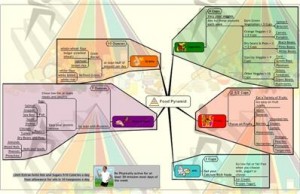An Idea Mapping Success Blogs Weblog
Idea Map #41 – Asymmetric Flaps
6 Sep 2007 Author: Jamie Nast In: idea mapping book, Idea Mapping Example, Mind Mapping Examples, Studying for Exams On September 4, 2007 I introduced you to pilot Michael Panebianco. He’s back with another example of how idea mapping is helping in training for emergency procedures. The asymmetric flaps map is an abnormal situation he had a few months back. It was the first map he did after buying the Idea Mapping book. He thinks it’s a poor map, but I disagree. If the map solves the problem or meets the purpose — it is a good map. It encompassed all of the things he will review for training. He keeps it for a reminder of where he started in his Idea Mapping journey, and because it is actually complete and useful to him.
On September 4, 2007 I introduced you to pilot Michael Panebianco. He’s back with another example of how idea mapping is helping in training for emergency procedures. The asymmetric flaps map is an abnormal situation he had a few months back. It was the first map he did after buying the Idea Mapping book. He thinks it’s a poor map, but I disagree. If the map solves the problem or meets the purpose — it is a good map. It encompassed all of the things he will review for training. He keeps it for a reminder of where he started in his Idea Mapping journey, and because it is actually complete and useful to him.
Jamie’s 30-Minute TV Interview Replayed This Week
5 Sep 2007 Author: Jamie Nast In: Radio/TV AppearancesBCTV will re-air Jamie’s 30-minute interview twice this week. (See the July 16, 2007 posting for details of Part 1). Part 2 will air for the first time next week on two occasions in several Metro Detroit suburbs. To watch a 7-minute clip of Part 1 click here.
Idea Map #40 – Aviation Emergency Procedure Training & Hint #14
4 Sep 2007 Author: Jamie Nast In: Idea Mapping Example, Mind Mapping Examples, Studying for Exams Meet airline pilot, Michael Panebianco. Michael created a map that we call “fires on the airplane map”. He used this map as a visualization tool to study for emergency procedures pilots can face. It presents the big picture of dealing with one of the most dangerous situations in aviation. While existing checklists are linear, this map allows a visual flow of the factors at work in dealing with a fire inside the aircraft. Operating in three dimensions with multiple concerns for safety, a good, big picture presentation helps build a mental path towards simultaneous actions. Michael has other maps that he uses for other aircraft malfunctions with similar time and action concerns. I’ll share those in subsequent postings.
Meet airline pilot, Michael Panebianco. Michael created a map that we call “fires on the airplane map”. He used this map as a visualization tool to study for emergency procedures pilots can face. It presents the big picture of dealing with one of the most dangerous situations in aviation. While existing checklists are linear, this map allows a visual flow of the factors at work in dealing with a fire inside the aircraft. Operating in three dimensions with multiple concerns for safety, a good, big picture presentation helps build a mental path towards simultaneous actions. Michael has other maps that he uses for other aircraft malfunctions with similar time and action concerns. I’ll share those in subsequent postings.
Announcing Two New Workshops
1 Sep 2007 Author: Jamie Nast In: Memory Workshops, Speed Reading Workshops What you believe about your ability to improve your memory and speed reading skills, impacts your ability to remember and read more quickly. This ultimately impacts your ability to gain knowledge and learn new skills.
What you believe about your ability to improve your memory and speed reading skills, impacts your ability to remember and read more quickly. This ultimately impacts your ability to gain knowledge and learn new skills.
Have you ever been taught how to remember or read more quickly? If you’re like most people the answer is “NO”. Would improving your memory and reading skills add value to your work and life? Of course it would!
I’ve been teaching memory tools and speed reading since 1992, but over the last two years have finally developed and tested two extremely successful designs. I’d like to thank my clients at BP for being the first to pilot the original format in 2006.
Both offerings are 1-day workshops and the links to the abstracts are:
1) Memory Power
2) Memory & Speed Reading
The purpose of these workshops is to teach individuals how to effectively gain and retain knowledge, improve productivity and focus, and increase their ability to learn more efficiently by teaching them memory (and speed reading) skills.
Give this gift to your organization today. It’s a workshop they’ll never forget!
 Daniel is a senior at the University of South Florida, and did his summer at a large automotive company in southeastern Michigan. One of his first assignments his manager gave him was to read the Idea Mapping book. I met Daniel in June and he was already becoming a huge fan and user of MindManager.
Daniel is a senior at the University of South Florida, and did his summer at a large automotive company in southeastern Michigan. One of his first assignments his manager gave him was to read the Idea Mapping book. I met Daniel in June and he was already becoming a huge fan and user of MindManager.You can see a clearer pdf version of this map on my website under “Additional Maps”. If you click on any column it will sort alphabetically and you can then search by author or title (Food Pyramid) of the map.
 Starting at $49 IntelliGantt Integrates Mindjet MindManager Pro with SharePoint and Groove. Team members can update and complete topics assigned to them with a web browser, as a Groove client, or as an IntelliGantt ‘smart’ client. The IntelliGantt Add-In for MindManager also works with hosted SharePoint solutions. Finally, because it installs on your local desktop, the IntelliGantt MindManager Add-In will keep track of changes you make offline and merge updates when you’re back online. Check it out!
Starting at $49 IntelliGantt Integrates Mindjet MindManager Pro with SharePoint and Groove. Team members can update and complete topics assigned to them with a web browser, as a Groove client, or as an IntelliGantt ‘smart’ client. The IntelliGantt Add-In for MindManager also works with hosted SharePoint solutions. Finally, because it installs on your local desktop, the IntelliGantt MindManager Add-In will keep track of changes you make offline and merge updates when you’re back online. Check it out!
Idea Map #38 – Back to School After 48 Years
23 Aug 2007 Author: Jamie Nast In: Idea Mapping Example, Idea Mapping Workshops, Studying for Exams Next month I will be heading to MTSU (Middle Tennessee State University) to teach 3 workshops for the 5th year in a row. Each year Dr. Carol Ann Baily (Director of Adult Services) gathers nearly 150 students for two 3-hour Idea Mapping Workshops and another 30 or so faculty for a workshop the following day. Last year Darlene Houston was one of the student participants. Her first map from last year is above. Here’s her story in her own words:
Next month I will be heading to MTSU (Middle Tennessee State University) to teach 3 workshops for the 5th year in a row. Each year Dr. Carol Ann Baily (Director of Adult Services) gathers nearly 150 students for two 3-hour Idea Mapping Workshops and another 30 or so faculty for a workshop the following day. Last year Darlene Houston was one of the student participants. Her first map from last year is above. Here’s her story in her own words:
“I was taking 15 credit hours as a full-time non-traditional student. Those first few weeks I felt overwhelmed by college Algebra since it had been 48 years since I’d taken it in High School. I was letting self-doubt for conquering Algebra take over my mind and it was effecting all my work. It was apparent that if I didn’t change my thought patterns I would be defeated in my quest for a college degree before I really began. I needed to let “I Can” explode through the ‘can’t’.
After the Idea Mapping Workshop the previous week, I decided to prepare for an upcoming Stagecraft test by turning my linear notes into an idea map. My test score was 96 using the map. I thought I was too busy to map for the next test, but I sure found using linear notes did not produce the same result. That score was 69.
Weeks after I did my map, I looked at it again and drew an exploding “I Can” coming up through the middle. There were several things I drew that were essential to know on the test. I can still see the “I Can” visual in my mind, and I draw upon that mental image to carry me through when the task looks too difficult.”
Idea Map #37 – Planning a Meeting
22 Aug 2007 Author: Jamie Nast In: Idea Mapping Example Don Snyder (better know as Don The Idea Guy) introduced me to Jim Canterucci, the author of a book called Personal Brilliance. Last month Jim and his wife Holly were in town, and I had a chance to meet with them in person. When Jim started the meeting he pulled out this map that he created using MindManager. I was so impressed that I had to show off his work. You’ll hear more about Jim in the future, but for now here is your introduction. To discover your Personal Brilliance Quotient, go to www.mypersonalbrilliance.com.
Don Snyder (better know as Don The Idea Guy) introduced me to Jim Canterucci, the author of a book called Personal Brilliance. Last month Jim and his wife Holly were in town, and I had a chance to meet with them in person. When Jim started the meeting he pulled out this map that he created using MindManager. I was so impressed that I had to show off his work. You’ll hear more about Jim in the future, but for now here is your introduction. To discover your Personal Brilliance Quotient, go to www.mypersonalbrilliance.com.Idea Map #36 – Learning French & Hint #13
20 Aug 2007 Author: Jamie Nast In: Idea Mapping Example, Idea Mapping Workshops, Mind Mapping Examples As another school year begins, learners around the globe might be encouraged to see an Idea Mapping example created by a fellow student, Erica Ervin. In 2002, Erica was a junior at Willow Run High School in Ypsilanti, Michigan. It was the first of several school years where I taught Idea Mapping to the students and faculty. In this map she outlines a chapter in her French book. Hint #13 is to create a map of a subject you need to remember, then review it on a daily basis until you can recreate it from memory. The 55 students who participated in this first group improved their average GPA’s by nearly half a point as a result of applying idea mapping to their studies.
As another school year begins, learners around the globe might be encouraged to see an Idea Mapping example created by a fellow student, Erica Ervin. In 2002, Erica was a junior at Willow Run High School in Ypsilanti, Michigan. It was the first of several school years where I taught Idea Mapping to the students and faculty. In this map she outlines a chapter in her French book. Hint #13 is to create a map of a subject you need to remember, then review it on a daily basis until you can recreate it from memory. The 55 students who participated in this first group improved their average GPA’s by nearly half a point as a result of applying idea mapping to their studies.
Mind Mapping Can Help Dyslexics
17 Aug 2007 Author: Jamie Nast In: ArticlesSteve Rothwell ran across this article in the BBC News. The article dicusses how visual memory and mapping tools help dyslexics write and achieve high marks at school and university.
- 0 Comments
- Tags: BBC News, dyslexia, education, Steve Rothwell, study tools
Idea Mapping Blog
The purpose of this blog is to share idea mapping examples and related learning from my Idea Mapping, Memory, Speed Reading, and Certification Workshops. This blog is dedicated to my Certified Idea Mapping Instructors, my clients, Mind Mapping and Idea Mapping practitioners around the globe.
![[Ask]](http://ideamapping.ideamappingsuccess.com/IdeaMappingBlogs/wp-content/plugins/bookmarkify/ask.png)
![[del.icio.us]](http://ideamapping.ideamappingsuccess.com/IdeaMappingBlogs/wp-content/plugins/bookmarkify/delicious.png)
![[Digg]](http://ideamapping.ideamappingsuccess.com/IdeaMappingBlogs/wp-content/plugins/bookmarkify/digg.png)
![[Facebook]](http://ideamapping.ideamappingsuccess.com/IdeaMappingBlogs/wp-content/plugins/bookmarkify/facebook.png)
![[Google]](http://ideamapping.ideamappingsuccess.com/IdeaMappingBlogs/wp-content/plugins/bookmarkify/google.png)
![[MySpace]](http://ideamapping.ideamappingsuccess.com/IdeaMappingBlogs/wp-content/plugins/bookmarkify/myspace.png)
![[Slashdot]](http://ideamapping.ideamappingsuccess.com/IdeaMappingBlogs/wp-content/plugins/bookmarkify/slashdot.png)
![[Sphinn]](http://ideamapping.ideamappingsuccess.com/IdeaMappingBlogs/wp-content/plugins/bookmarkify/sphinn.png)
![[StumbleUpon]](http://ideamapping.ideamappingsuccess.com/IdeaMappingBlogs/wp-content/plugins/bookmarkify/stumbleupon.png)
![[Technorati]](http://ideamapping.ideamappingsuccess.com/IdeaMappingBlogs/wp-content/plugins/bookmarkify/technorati.png)
![[ThisNext]](http://ideamapping.ideamappingsuccess.com/IdeaMappingBlogs/wp-content/plugins/bookmarkify/thisnext.png)
![[Twitter]](http://ideamapping.ideamappingsuccess.com/IdeaMappingBlogs/wp-content/plugins/bookmarkify/twitter.png)
![[Webride]](http://ideamapping.ideamappingsuccess.com/IdeaMappingBlogs/wp-content/plugins/bookmarkify/webride.png)
![[Email]](http://ideamapping.ideamappingsuccess.com/IdeaMappingBlogs/wp-content/plugins/bookmarkify/email.png)